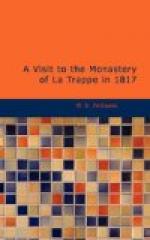This spot is now marked by a wooden cross, enclosed by an iron railing. The remains of the Prince were dug out on the 20th March, 1816, by order of Louis XVIII. and deposited with solemn funeral ceremony in a coffin which is placed in the same apartment where the council of war condemned him to suffer! since transformed info a chapel. Under a cenotaph, covered with a cloth of gold, is placed the coffin, with a prodigious large stone lying on it, the same that was found lying on his head, and which from its weight had crushed his skull!
The apartment is hung with black cloth, and remains continually lighted, with a guard placed over it. Mass is daily performed for the repose of his soul, agreeable to the Catholic religion.
On the lid of the coffin is the following inscription:
Ici est Le Corps
De Tres-Haut, Tres-Puissant Prince
Louis-Antoine-Henri De Bourbon
Duc D’Enghien, Prince du Sang
Pair de France
Mort A Vincennes, Le 21 Mars 1804
A L’age de XXXI Ans VII mois XVIII
Jours.
A marble bust of the Prince, by Bosio, is placed at the entrance.
During the periods of 1814 and 1815, when Paris was in possession of the Allies, Vincennes continued under the command of General Daumesnil, who declared that he held it for his country until the Government was settled, and would not open its gates to a foreign army. It was not attacked either of the times.
It is approached by two gates, with drawbridges, and defended by cannon on all sides. The fosse is of great depth, and dry, extending, I should suppose, nearly a quarter of a mile. It has nine towers, of prodigious height and solidity: the largest, at the south western angle, called the Donjon, is considerably more elevated than the others. The principal entrance is fronting the forest, on the north side, in the form of a triumphal arch, with six pillars, ornamented in bas-reliefs, and was decorated with marble statues, which were destroyed when it was seized by the mob.
The Donjon is surrounded by a separate ditch, within the other, of forty feet depth, and is approached by two draw-bridges; one for carriages, the other for foot passengers; and the main tower is flanked by four other angular ones, each having a high turret. The windows are treble barred within and without, so as to admit but a faint glimmering light! Three gates of great solidity are to be passed at the entrance; that which communicates with the draw-bridge of the castle is secured both within and without. After passing the three gates, there is a court, in the middle of which stands the Donjon. Three other immense gates guard its entrance!




